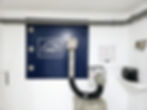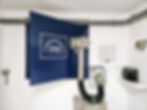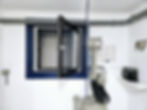
Shelter Components
The German Shelter Center is the official trading partner for shelter components from the Swiss manufacturer Mengeu AG. The traditional company has over 60 years of manufacturing experience and its production is certified according to ISO 9001:2015.
All shelter components we offer are tested and approved according to the standards and regulations of the Swiss Federal Office for Civil Protection (FOCP).
The German Federal Office of Civil Protection and Disaster Assistance (BBK) does not have any legal requirements or approvals for the construction of shelters in Germany.

Shelter closures
Armoured doors and armoured covers protect the entrances and emergency exits of bunkers and shelters and provide protection against:
Air blast pressure waves from nuclear and conventional explosions
Radioactive primary radiation from nuclear power plant accidents and atomic bombs
Heat waves and fragments from nuclear and conventional bombs
Poison gas contamination from industrial accidents and military chemical warfare agents
Armoured doors, pressure doors and armoured covers consist of a steel reinforcement frame that must be concreted directly on site.
The installation of the armored door and the armored cover should be carried out during the basement conversion, since subsequent installation is hardly possible due to the high weight in the unconcreted state (armored door PT1, 200 kg).
In the best case scenario, the components are therefore encased in concrete in the basement during the construction of a new residential / commercial property.
Overview of shelter closures:
Armored doors
Armoured gates
Armored cover
Pressure doors

Armored doors (PT)
Armoured doors seal the entrances to shelters/ nuclear bunkers / air raid shelters gas-tight and pressure-tight and are installed and concreted on the outside of the shelter. In the event of a pressure surge, the armoured door is pressed onto the shelter shell and protects the occupants.
The armored door is locked from the inside with two solid lever locks and is secured against entry from the outside with a locking device.
Armored doors are available in four different sizes (PT1 – PT4).
Armoured door PT1 (standard size for shelter entrances)
External closure for protective structures up to 3 bar
Armoured door with outward-facing hinge
Version with fixed or removable door threshold possible
Can be used left and right
Wall frame made of angle steel profiles with anchor plates
Door leaf with groove and sealing rubber
Welded reinforcement
Lever locks with locking mechanism
Tube for self-release device
Width: 80cm
Height: 185cm
Thickness: 20 cm
Weight without concrete filling: 200 kg

Self-release device
The self-escape device is required if the armored door is blocked by debris from the outside and it is not possible to leave the bunker even via the emergency exits.
With the self-release device, a blocked armored door (PT1 – PT3) can be mechanically pressed open up to a passage width of 35 cm.
Self-release device for armored door PT1 - PT3
-
Self-releasing bolt square nut
-
Open-end wrench SW 55
-
Self-liberation plate
-
Wing nut

Armoured sliding walls (PSW)
Armoured sliding walls (PSW) are installed in larger civil defence facilities, which are usually used as underground car parks for cars when there is no threat. In contrast to armoured doors, which are concreted into the walls of the shelter, armoured sliding walls are located in a floor and ceiling channel.
The production of the armored sliding walls takes place individually in Switzerland, which means that individual dimensions and customer requirements are possible.

Armoured sliding walls
Can be mounted inside or outside
Maximum height: 2.40 m
Maximum width: 7.00 m
Custom-made

Pressure doors (DT)
Pressure doors separate different shelter compartments from each other in a gas- and pressure-tight manner and are installed inside the shelter shell and lined with concrete. The difference to the armored door with a thickness of 20 cm is that the pressure door is designed with a thickness of 10 cm.
Pressure doors are used in locks and larger shelters and bunkers.
Pressure doors are available in three different sizes (DT1 – DT3).
Pressure door DT1 (standard size for shelter partitions)
External closure for protective structures up to 3 bar
Pressure door with outward stop
Version with fixed or removable door threshold possible
Can be used left and right
Wall frame made of angle steel profiles with anchor plates
Door leaf with groove and sealing rubber
Welded reinforcement
Lever locks with locking mechanism
Tube for self-release device
Width: 80cm
Height: 185cm
Thickness: 10 cm
Weight without concrete filling: 115 kg

Armoured cover (PD)
Armoured covers seal the emergency exits of bunkers and shelters gas- and pressure-tight and are installed on the inside of the shelter shell and filled with concrete. If an armoured door is buried or blocked, the armoured cover can be opened inwards and allow people to exit the shelter.
Like the armored door, the armored lid is locked from the inside with two solid lever locks and secured with a locking device to prevent unauthorized entry.
Armoured lid PD (standard size)
External closure for protective structures up to 3 bar
Armoured cover with stop to the outside
Version with fixed or removable door threshold possible
Can be used left and right
Wall frame made of angle steel profiles with anchor plates
Door leaf with groove and sealing rubber
Welded reinforcement
Lever locks with locking mechanism
Tube for self-release device
Width: 60cm
Height: 80cm
Thickness: 20 cm
Weight without concrete filling: 140 kg

Protective cover
With the help of a protective cover, existing basement rooms can be converted into temporary shelters. The cover is mounted over a basement window, which can protect the shelter occupants from pressure waves, (glass) splinters and, in combination with a ventilation system, from nuclear, biological and chemical warfare agents in the event of an incident.
In times of peace, the lid is open, allowing the window to be used in the usual way. In the event of a disaster or attack, the lid can be closed and the light shaft filled with sandbags.
The covers are custom-made to the dimensions of the respective windows. The number of locks and wall fastenings is determined individually as part of a static calculation.
Protective cover
For the conversion of existing cellars
to temporary sheltersCustom-made to individual window dimensions
Design according to static calculation
Welded steel construction
Gas-tight thanks to all-round sealing rubber
Multi-point locking
- Optionally with connection for shelter ventilation
- Optionally hot-dip galvanized and painted in RAL colors




Manhole covers for emergency exits and escape tunnels
Emergency exits can be closed using these special stainless steel covers. The cover is supported by gas pressure springs when opening. Different variants are installed depending on the application:
Manhole cover with ventilation chimney
Versions:
Burglar resistant RC3
Suitable for Ex zone 1



Manhole cover flush, drivable, rainproof
This driveable manhole cover can be installed flush with the surface, meaning it can be covered inconspicuously with soil. Air flow is ensured with a separate ventilation chimney.
Versions:
Burglar resistant RC3
Can be driven on up to 60 tonnes
Suitable for Ex zone 1
Panic room – security doors, windows and facades
We offer special security doors, windows and facade elements for the construction of panic and shelter rooms. The security elements can provide combined protection against burglary, bullet holes, explosions, fire and smoke up to the highest security classes.
We work with various manufacturers depending on the requirements and protection concept. The tested and certified safety elements are manufactured individually in Germany for each construction project according to our specialist planning.
Classifications – Burglar resistance
Given the high number of burglaries and low detection rates, effective protection against attempted burglaries plays a particularly important role in building security.
In this security segment, we offer a wide range of tested and certified doors, windows, facades, grilles and many other security products.


Classifications – Bullet resistance
Security doors, windows and facades that have been tested and certified for bullet resistance prevent bullets from being fired with a wide variety of weapon systems and types of ammunition.
Evidence of effective bullet resistance is provided by numerous test certificates from accredited testing institutes in accordance with international safety standards; the protection class is selected according to customer-specific specifications.

Fully glazed high security doors and sheet steel doors - Individual design
The doors, windows and facade elements are manufactured individually according to customer requirements. Examples:


Shelter and bunker ventilation
Shelter ventilation systems essentially consist of a fan, a pre-filter and a gas filter (activated carbon filter), which ensures the supply of fresh air in the shelter.
The ventilation system is electrically operated, with the air drawn in being processed by two filter stages. In addition, in the event of a power failure, the ventilation system can be operated using a hand crank.
First, the contaminated air is passed through the particulate filter, which filters out all suspended and contaminated particles from the outside air that is sucked in. The contaminated air is then sucked through the gas filter, where the activated carbon absorbs dangerous poison gas molecules.
The cleaned outside air is then fed into the shelter by the fan. The air overpressure in the shelter created by the intake also ensures that the used breathing air is discharged to the outside via an overpressure explosion protection valve.
In addition, a slight overpressure in the shelter (at least 50 Pa and a maximum of 250 Pa) ensures that no poisonous gases can enter from the outside, even through possible leaks in the shelter.
Depending on the concentration of toxins in the outside air, the gas filter (activated carbon filter) can be used safely for several days and weeks.

Ventilation system (VA)
There are three different sizes of ventilation systems. The size of the system depends primarily on the number of shelter spaces in the shelter:
Ventilation system VA 40: max. 13 people
Ventilation system VA 75: max. 25 people
Ventilation system VA 150: max. 50 people
Ventilation system VA 40/ 75/ 150
-
Fan VA 40/75/150
-
Electric motor and hand drive
-
Dynamo and emergency light
-
Hand crank (in case of power failure)
-
Mounting tabs
-
Plastic wrapping
-
-
Gas filter GF 40/75/150 (filter class H14)
-
Mounting rail
-
Plastic wrapping
-
-
Explosion protection valve / pre-filter ESV/VF 40/75/150 (filter class G4)
-
Coarse dust filter
-
Condensation bottle
-
Plug-in grille NW 125
-
-
Air flow meter LM 40/75/150
-
Air measuring unit
-
throttle
-
-
Overpressure/explosion protection valve UEV/ESV 40/75/150
-
Mounting tabs
-
Plug-in grille NW 125
-
-
Corrugated hose pair complete
-
Corrugated hoses
-
coupling
-
-400w.png)

Shelter facility
In non-threat times, shelters can be used as basement compartments, hobby rooms or as a protected storage place for electronic data storage devices, valuables, etc. In the event of a threat, the shelter can then be occupied.
Since it is assumed that the duration of stay in the shelter is limited, a toilet with water and sewage connections in the shelter can be dispensed with for cost reasons.
According to the Swiss shelter concept, shelters are normally equipped with dry toilets.
Additional heating is usually not necessary, as the enclosed shelter is tempered by the body temperature of the occupants.

Dry toilet (TC)
The dry toilets consist of a plastic waste bucket with a seat/lid and one or more sets of waste bags.
The water and chemical-independent system is extremely simple and therefore the optimal principle for emergency situations: A waste bag is placed in the insert and closed after use. The bag is then stored in the depot bucket, which is lined with a waste bag. The waste bucket is sealed airtight with a lid.
Depending on the size of the shelter, different dry toilet sets must be selected:


Berths
Berths for compulsory shelters
This berth offers an inexpensive and space-saving sleeping option in the bunker and shelter. There are two different versions:
Version with fabric covering
Space-saving in non-threat times
Beds can be packed, e.g. stored in the toilet cubicles
Version with chipboard
Can also be used as a storage rack during non-threat times

Staff berths
For greater comfort, we also offer so-called "personnel beds". The shelter beds consist of 19 mm thick chipboard and a solid, shock-tested tubular steel construction.
The load capacity per level is 250 kg, which means the bed can also be used as a storage space.
These beds are available in the following variations:
2-storey
3-storey

Take responsibility for your own safety.

We, the German Shelter Center, offer you the opportunity to build a shelter for private precautions within your own four walls.
We offer you:
Advice on shelter construction
Planning of shelters
Sales of shelter components and furniture
Assembly of shelter components and furniture
We are happy to answer any questions you may have!











